?
Akira Shimizu - Menuma Collage

Shimizu, motivated by the memory of his childhood, continues to seek something indefinable, frightening and nostalgic.@It bears fruit as the collage series, Menuma. (This title originally came from the name of the district where he lives.) Tatsumi Hijikata, Shimizufs friend, a Japanese choreographer and the founder of a dance performance art called Butoh wrote a comment on the collage series, referring to Shimizu as "an artist of the hunter of thunder and lightening".
He said gWhen I first saw this series, I felt as if I was in rapture. I think the artistfs intention for this collages series was to try to find out the little secret space that existed between Shimizu and the viewer. It seems the smaller the space between Shimizu and me (viewer), the higher my level of rapture. This might be what the artist intended to happen.h
Many motifs used in this series are related to Shimizufs own visions and memories of his childhood. For example, he uses barbershopfs sign poles, scissors and the snow scene of a suburb in Japan. These motifs were very familiar to young Shimizu whose father ran a barber shop in Toyama city which is famous for heavy snowfalls.
The artist was born in Shimizu town, a seaside town facing the Sea of Japan, located in the central part of the mainland of Japan, called the Hokuriku Area. In 1945, when Shimizu was nine, he moved to a fishermanfs house in Iwase Beach which faces Toyama Bay. It coincided with the end of WWII. His family rented the upstairs floor of the home of the fisherman who was a relative. This was the place where he witnessed both life and death.

Friction Line
1970
Collage
23.2(H) x 16.4(W) (cm)
The National Museum of Art, Oosaka
The experiences and the images that burnt into his brain continues to inspire Shimizu again and again.
He is also so intuitive that he sometimes let his hand move on the paper and canvas by itself. He said, g the imageries are born one after another and they whisper in my ear to embody them.h
The background is the Sea of Japan, and in winter thunderstorms come often to Hokuriku area. The scenery of this dark Sea of Japan just implies the period of the end of WWII. Barber scissors and the lying crabs compete in a seashore line each other. They never compromise. They will keep fighting until either the scissors or the crabs collapse in the end. (MK)
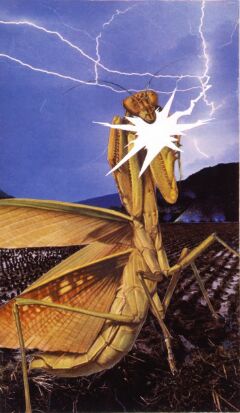
Thunder-lightning Hunter
1970
Collage
29.3(H) x 17.1(W) (cm)
The National Museum of Art, Oosaka
Thunder lightning often falls at a cold snowy day in the Sea of Japan. People call such weather as gYellowtail Causingh, and it is said that on such day, the fishermen can catch big amount of yellowtail. Not only it lures yellowtail to come, but also it falls on the field and stirs up the small creatures. The mantis defies the lighting to fight with its whole body. For him it is impossible to fight with the sickle alone. The mantis, defying man-to-man fight, captures lightning at last, and becomes a part of it. (MK)
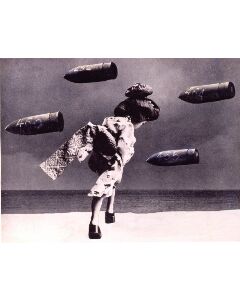
Going like Sugoroku(Japanese Backgammon)
1970
Collage
15.4(H) x 19.6(W) (cm)
The National Museum of Art, Oosaka
A girl with a classic Japanese hairstyle walks along the coastline tilting her head slightly to the right. She wears a pair of black-lacquered Pokkuri, wooden sandals, which make a monotone contrast in the white sand. In the background are four bombshells which mysteriously float in the air.
Shimizu is not a pacifist; however, he sometimes uses motifs which are related to war. In 1945, at the end of WWII, young Shimizu who lived near the shore of the Sea of Japan witnessed life and death. Because he named it gGoing like Sugorokuh, a Japanese traditional game similar to Backgammon, Shimizu might have felt that the fate of the Japanese people in that period would be left to the dice of Sugoroku.
He also said, gThe imageries are born one after another and they whisper in my ear to embody them.h These never ending inspirations are the sources of energy for this artist who still continues to work vigorously.(MK)

Canyon of Ecstasy
1970
Collage
26.3(H) x 12.8(W) (cm)
The National Museum of Art, Oosaka
When being shampooed at a barbershop, you may reach into feeling of ecstasy. This feeling approaches to the stage of perfect serenity of mind, like that of a training monk beaten in the waterfall. Shomyo Waterfalls, 350 meters gap and the maximum level in Japan, is located in Tateyama mountainous city in Toyama prefecture. It is said that the name originates from the fact that the founder of Jodo Shinshu (Pure Land Buddhism) heard the sound of the waterfall like the prayer to Amida Buddha (Namu Amida Butsu). Everyone who visits this waterfall is nailed down to the divineness. On such occasion, the soul transcends both time and space border, and enjoys another world. (MK)
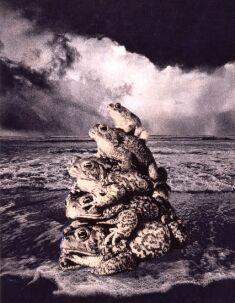
Blind Watchtower
1970
Collage
22.1(H) x 14.6(W) (cm)
The National Museum of Art, Oosaka
Here is the artistfs paradoxical wit in the name of this work. Five flogs with sleepy eyes make a tower. Viewers are prompted to wonder what do they watch at the seashore in this dark weather. With such sleepy eyes, their enemy may attack them easily, rather than they find the enemy. This metaphoric collage may also imply the image of Japan in the War period.(MK)
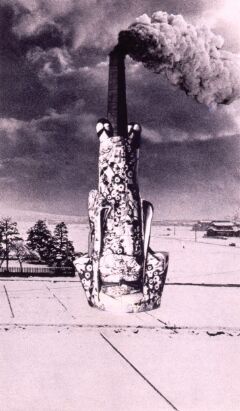
Girl Factory
1970
Collage
24.9(H) x 14.6(W) (cm)
The National Museum of Art, Oosaka
It is a chimney sticking out from the body of a girl with kimono who turns upside down. The background is the pastoral landscape in a snowy country. The chimney is emitting smoke in great profusion.
Modern Japanese industries achieved surprising development by the government policies in which factories like silk mils, railroads and mining industry were established in the Meiji era. On the other hand, boys and girls were sometimes forced to do severe labor, while the beautiful nature was damaged behind the scenes. Such a social criticism may be put in this composition. (MK)
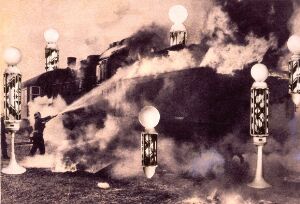
Whipped Signpoles
1970
Collage
13.2(H) x 19.1(W) (cm)
The National Museum of Art, Oosaka
The locomotive is burning while emitting dark smoke. The firefighter wrestles with the fire, and there are several signpoles around the locomotive. The more the firefighter becomes frantic to extinguish the fire, the more the sighpoles stirs up the flame with its symbolic rotating body. It depicts the image of Japan, rushing into to the War. Some tried to stop it, while some stirred it up. (MK)
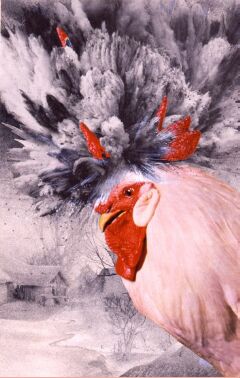
Rooster's Pulses
1970
Collage
22.6(H) x 14.7(W) (cm)
The National Museum of Art, Oosaka
Roosterfs cockscomb explodes, and in the background there is a seemingly farmerfs house in northern provinces. Mysterious silence intersects with the roaring. Only crimson color of cockscomb shines in this monochrome composition. The color means blood that symbolizes glifeh.
Bombing attacks the pastoral area in quiet northern provinces suddenly. Toyama city, the artistfs hometown was bombed in August 1945, too. Shimizu said that spectacle where only a mailing post remained alone had burnt into his brain after the air raid. Later he made several objet dfarts of distorted posts.(MK)

Taking-away His Breath
1970
Collage
11.9(H) x 14.6(W) (cm)
The National Museum of Art, Oosaka
The motif of diving bird is also used in RECREATION (1962). This motif reminds me the image of Kamikaze, the special attack corps, or suicide bomber. "Breath" is a symbol of the life. The birdfs mission is to take gthe Breathh away, and he dives into the bridge. Once he dives, he cannot pull out his head. However, transcending the borderline, he may see new world that extends underground. Now he is liberated from the current mission.(MK)
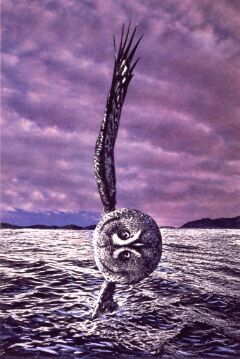
Ocean Pole
1970
Collage
23.1(H) x 15.6(W) (cm)
The National Museum of Art, Oosaka
It reminds me a scene once I had in my dream. A huge pole stands in an ocean. However, when it comes to a pillar of an owl, it is completely surprise. The owl that flies vertically with his one wing sticking into the sea, cuts the ocean. He stares the vicinity with his whole body, like a submarine that just comes out from the deep sea. And his eyes, that aim his prey, are pointed to us.(MK)
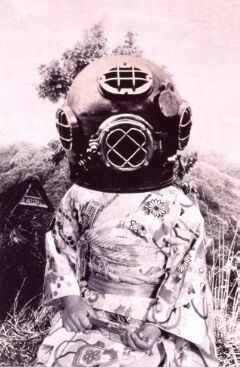
Iron Mask
1970
Collage
19.6(H) x 12.8(W) (cm)
The National Museum of Art, Oosaka
In the background, it is a farmerfs traditional house of Hokuriku area, the artistfs hometown. The girl with Kimono wears a diving helmet of standard diving dress, which produces strange atmosphere. But the weight of the helmet might be enough to symbolize the hardships women who endured hardships during the War. It would be almost impossible for the girl to take off this heavy helmet by herself. You can easily imagine how sad she is because she cannot see her beautiful appearance with this helmet on. Meanwhile silent helmet produces grotesque atmosphere and tension by itself.(MK)
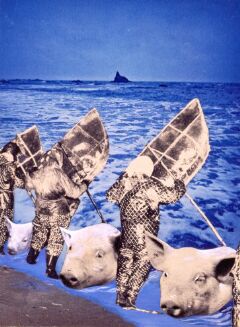
Blossom and Current
1970
Collage
20.0(H) x 14.9(W) (cm)
The National Museum of Art, Oosaka
The appearance of fishermenfs wives working earnestly is stout and beautiful. That the pigs stick their heads from the sea means they search for food with their sense of smell for human beings. Moreover, they symbolize humansf sacrifice offering their bodies. Pig might be one of the victims in modern civilization.
A small island is shown in the background, and it reminds me a scene in my dream long time ago. The seashore line that is interwoven by the woman and the pigs invents mysterious harmony. And it brings out something I forgot from the deep sea of my mind.(MK)

Poster for "Mandala Yashiki(Mandala Premises)" Tomiko Takai's Butoh Performance
1968
Paper, Print
102.51(H) x 72.0(W) (cm)
The National Museum of Art, Oosaka

© 2010 Akira Shimizu. All rights reserved














